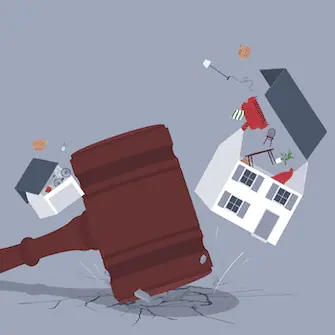2023 Study: The Shocking Rise of Eviction- and Foreclosure-Related Moves
Posted in: I'm Moving, Moving AdviceKey Findings
- Over 200,000 Americans had to move due to eviction or foreclosure in 2022
- The number of eviction/foreclosure-related moves rose 56% from 2021 to 2022
- California (+411%), Florida (+187%) and Massachusetts (+105%) saw the highest increase in moves following evictions and foreclosures
- Single parents (43%) and single mothers (79%) were more likely to move due to eviction or foreclosure than their married or childless counterparts
- Black (+23%) and Hispanic (+14%) people were more likely to be among those forced to move after losing their home compared to white Americans
- One in six (16%) of renters report being “very likely” to get evicted in the next two months in 2023
One of the most striking and worrying findings from our latest migration report was that last year, the number of Americans who moved due to “foreclosure or eviction” was 56% higher than the year prior.
To better understand this trend, we delved into these worrying figures to see who has been the most affected, as well as to highlight where in the United States the number of moves resulting from evictions and foreclosures is rising most rapidly.
 Eviction- and Foreclosure-related Moves on the Rise
Eviction- and Foreclosure-related Moves on the Rise
Unfortunately and unsurprisingly, a big reason for this jump in evictions and foreclosures was due to the fact that America’s homeownership and homelessness problems are getting worse.
These numbers were made worse in large part due to rising inflation, as well as federal rent assistance running out. These factors caused foreclosures and evictions to spike in 2022, which left thousands of Americans in need of a new home they can afford. (More on this below.)
How many foreclosures were there in 2022?
Based on data from ATTOM, a private real-estate data agency, there were 324,237 foreclosures in the U.S. in 2022.
(It’s worth noting that while this is more than double (+115%) the number of foreclosures in 2021, that figure is still lower than pre-pandemic levels.)
How many evictions were there in 2022?
While foreclosure statistics are more readily available, hard data on evictions is notoriously sparse due to being recorded inconsistently, often in hand-written form, or not recorded at all.
“While a few cities (such as Los Angeles) extended eviction moratoriums through to 2023, for the most part, all those protections are now gone in virtually all U.S. states.”
According to the data from Eviction Lab, an eviction data research agency out of Princeton University, eviction filings saw an 81% uptick in 2022. (However, that stat only covers 32 cities across the ten states they are currently able to track.)
How have these trends affected moving within the US?
While the total number of eviction/foreclosure-related moves is lower than it was in the mid-2010s (it’s been falling steadily since 2017), that all changed dramatically last year.
Data from the U.S. Census Bureau shows that as many as 204,000 Americans were forced to move in 2022 after being evicted or having had their property foreclosed — which resulted in a rate increase of 56% — the highest since the pandemic started.
See prices for movers by the hour – instantly.
Read real customer reviews.
Easily book your help online.
Why Foreclosures and Evictions are On the Rise: End of Federal Protections and High Inflation
If eviction- and foreclosure-cited moves jumped 56%, then it follows that the growth in the number of evictions and foreclosures must have also spiked significantly … right?
“Black (+23%) and Hispanic (14%) people are much more susceptible to being evicted or losing their homes to foreclosure than their white counterparts.”
But according to some experts, they didn’t. Statistically, both evictions and foreclosures were actually artificially reported as “low” in the preceding years of 2020 and 2021, because would-be eviction and foreclosure moves were uniquely held at bay by pandemic-related protections instated by the U.S. government for both homeowners and renters, at both the federal and state levels. With those protections now fading away, that rate couldn’t sustain itself.
On top of that, people had to simultaneously deal with historically high inflation and mortgage interest rates, making their financial situation even more precarious.
What were the pandemic-era protections for renters and homeowners?
As part of the legislative pandemic response in the United States, the CARES Act provided new foreclosure moratoriums and mortgage forbearance options for homeowners at the federal level.
Meanwhile, renters received help in the form of rental assistance and a moratorium on all evictions. But most of these protections ran out in the middle of 2021, just as America was economically moving past the pandemic.
While a few cities (such as Los Angeles) extended eviction moratoriums through to 2023, for the most part, all those protections are now gone in virtually all U.S. states.
The States Where Eviction and Foreclosure Moves are Spiking Most
Figures from the U.S. government’s Current Population Survey suggest California is the state where the number of moves forced by eviction and foreclosure jumped most significantly.
Another state experiencing a drastic rise in the number of foreclosure- and eviction-related moves was Florida. In the Sunshine State, the year-over-year growth rate of such moves was up 187% in 2022.
Massachusetts is the third and final state where eviction/foreclosure moves doubled year over year, rising by as much as 105% in 2022, compared to the year before.
Unfortunately, eviction-only data does not exist at neither the state nor federal level, making it next to impossible to make city-level comparisons. However, it’s safe to say that states that rank high on foreclosure-related graphs may also be unfortunate candidates for eviction-related ramifications.
“The U.S. Census Bureau’s Household Pulse Survey found that in February 2023, 16% of renters said they were likely to be evicted within two months.”
People of Color and Single Parents: Demographics of Eviction and Foreclosure Movers
Reflecting the demographics of eviction movers, it’s people of color and single parents who are much more likely to report being at risk for eviction in early 2023.
Single parents are 43% more likely to be among those moving due to eviction and foreclosure than those married or those without children in the household. For single mothers, the over-representation rate sits at 80% more likely to be evicted and foreclosed on.
As frequently reported, single parents and especially single mothers were much more likely to drop out of the labor force to take care of children during the pandemic. They were also much more reliant on COVID-related protections from the government, without which many now struggle to afford their home.
Consistent with findings of previous studies, Black (+23%) and Hispanic (14%) people are much more susceptible to being evicted or losing their homes to foreclosure than their white counterparts.
Age-wise, members of Generation X (+33%) are most over-represented among those who had to move after losing their homes. Interestingly, millennials were 16% less likely to be among eviction and foreclosure movers in 2022.
Renting on the Brink: Risk of Eviction is Rising in 2023
Detailed statistics on the number of Americans getting evicted or losing their home to repossession may not exist, but we do have a good indication of how many are on the brink of losing their homes.
The U.S. Census Bureau’s Household Pulse Survey found that in February 2023, 16% of renters said they were likely to be evicted within two months. About 4% of those who own their home reported being likely to have their home repossessed.
In volume, that’s 1.3 million renters and 175,000 homeowner households that may have to relocate due to being unable to keep up with rent or mortgage payments.
While the share of homeowners grappling with the risk of foreclosure is at a one-year low, the share of renters falling further and further behind in rent arrears is at a 5-month high.


 Eviction- and Foreclosure-related Moves on the Rise
Eviction- and Foreclosure-related Moves on the Rise


